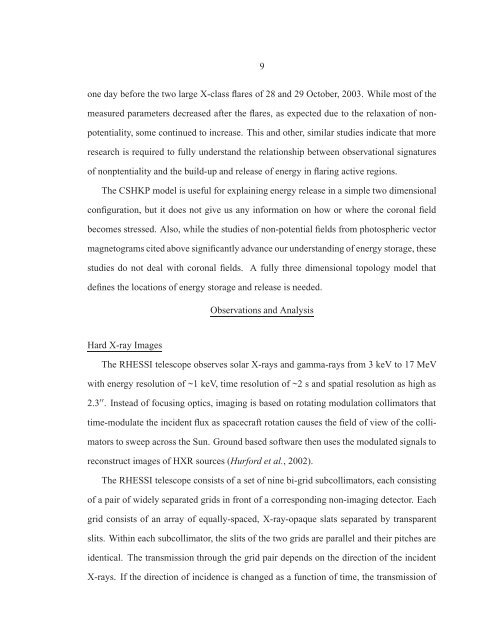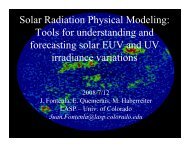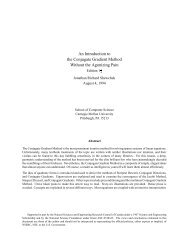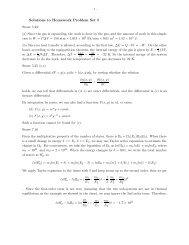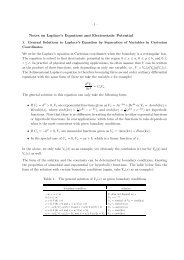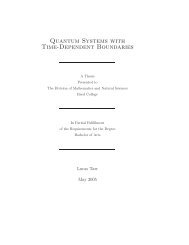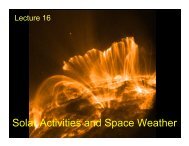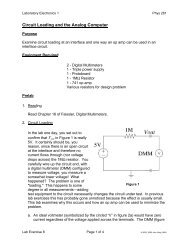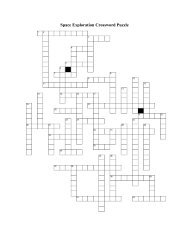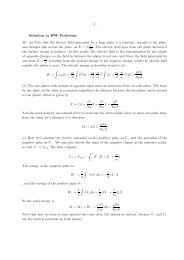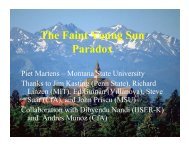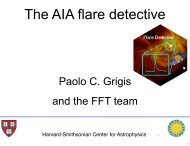The Topology of Magnetic Reconnection in Solar Flares
The Topology of Magnetic Reconnection in Solar Flares
The Topology of Magnetic Reconnection in Solar Flares
Create successful ePaper yourself
Turn your PDF publications into a flip-book with our unique Google optimized e-Paper software.
9one day before the two large X-class flares <strong>of</strong> 28 and 29 October, 2003. While most <strong>of</strong> themeasured parameters decreased after the flares, as expected due to the relaxation <strong>of</strong> nonpotentiality,some cont<strong>in</strong>ued to <strong>in</strong>crease. This and other, similar studies <strong>in</strong>dicate that moreresearch is required to fully understand the relationship between observational signatures<strong>of</strong> nonptentiality and the build-up and release <strong>of</strong> energy <strong>in</strong> flar<strong>in</strong>g active regions.<strong>The</strong> CSHKP model is useful for expla<strong>in</strong><strong>in</strong>g energy release <strong>in</strong> a simple two dimensionalconfiguration, but it does not give us any <strong>in</strong>formation on how or where the coronal fieldbecomes stressed. Also, while the studies <strong>of</strong> non-potential fields from photospheric vectormagnetograms cited above significantly advance our understand<strong>in</strong>g <strong>of</strong> energy storage, thesestudies do not deal with coronal fields. A fully three dimensional topology model thatdef<strong>in</strong>es the locations <strong>of</strong> energy storage and release is needed.Observations and AnalysisHard X-ray Images<strong>The</strong> RHESSI telescope observes solar X-rays and gamma-rays from 3 keV to 17 MeVwith energy resolution <strong>of</strong> ~1 keV, time resolution <strong>of</strong> ~2 s and spatial resolution as high as2.3 ′′ . Instead <strong>of</strong> focus<strong>in</strong>g optics, imag<strong>in</strong>g is based on rotat<strong>in</strong>g modulation collimators thattime-modulate the <strong>in</strong>cident flux as spacecraft rotation causes the field <strong>of</strong> view <strong>of</strong> the collimatorsto sweep across the Sun. Ground based s<strong>of</strong>tware then uses the modulated signals toreconstruct images <strong>of</strong> HXR sources (Hurford et al., 2002).<strong>The</strong> RHESSI telescope consists <strong>of</strong> a set <strong>of</strong> n<strong>in</strong>e bi-grid subcollimators, each consist<strong>in</strong>g<strong>of</strong> a pair <strong>of</strong> widely separated grids <strong>in</strong> front <strong>of</strong> a correspond<strong>in</strong>g non-imag<strong>in</strong>g detector. Eachgrid consists <strong>of</strong> an array <strong>of</strong> equally-spaced, X-ray-opaque slats separated by transparentslits. With<strong>in</strong> each subcollimator, the slits <strong>of</strong> the two grids are parallel and their pitches areidentical. <strong>The</strong> transmission through the grid pair depends on the direction <strong>of</strong> the <strong>in</strong>cidentX-rays. If the direction <strong>of</strong> <strong>in</strong>cidence is changed as a function <strong>of</strong> time, the transmission <strong>of</strong>


